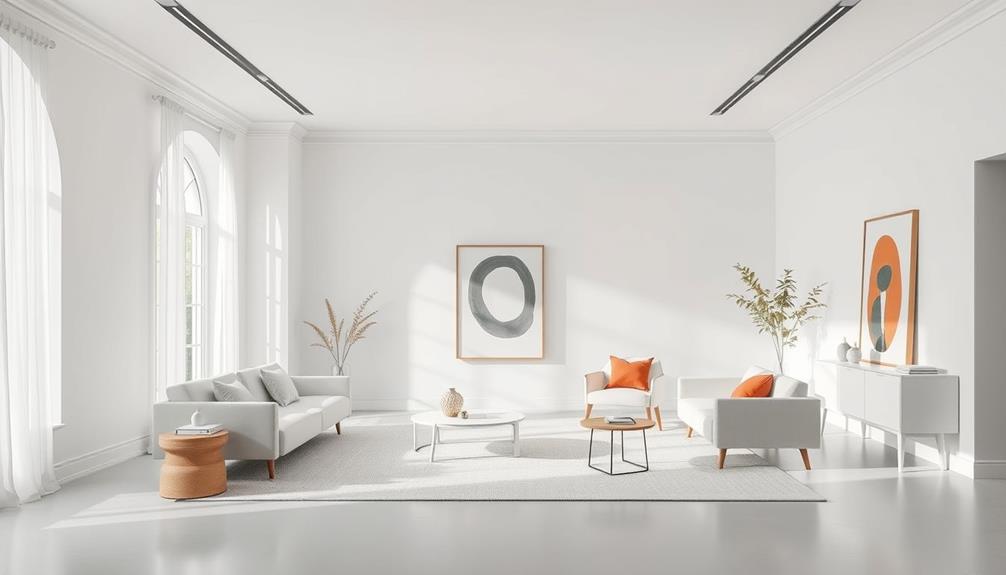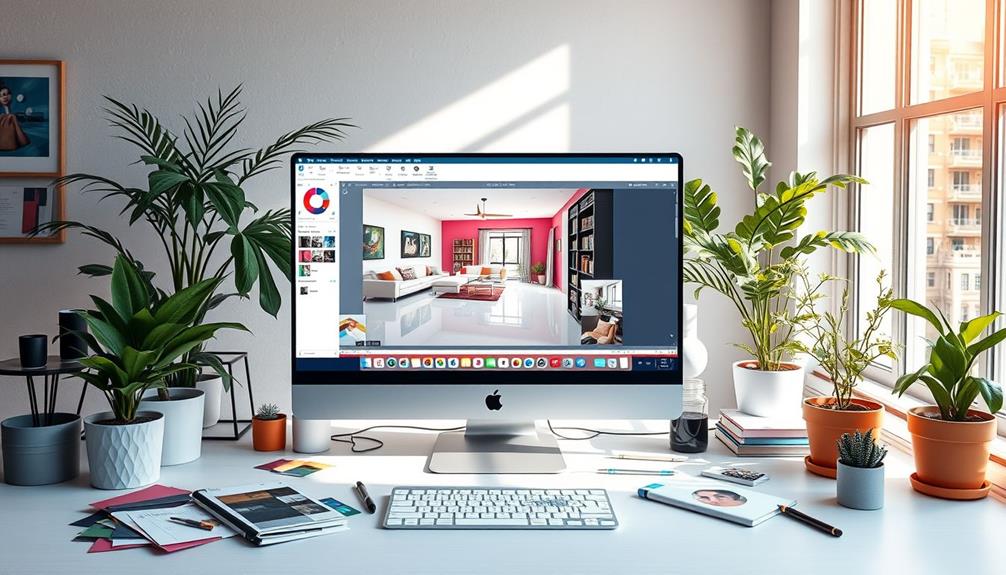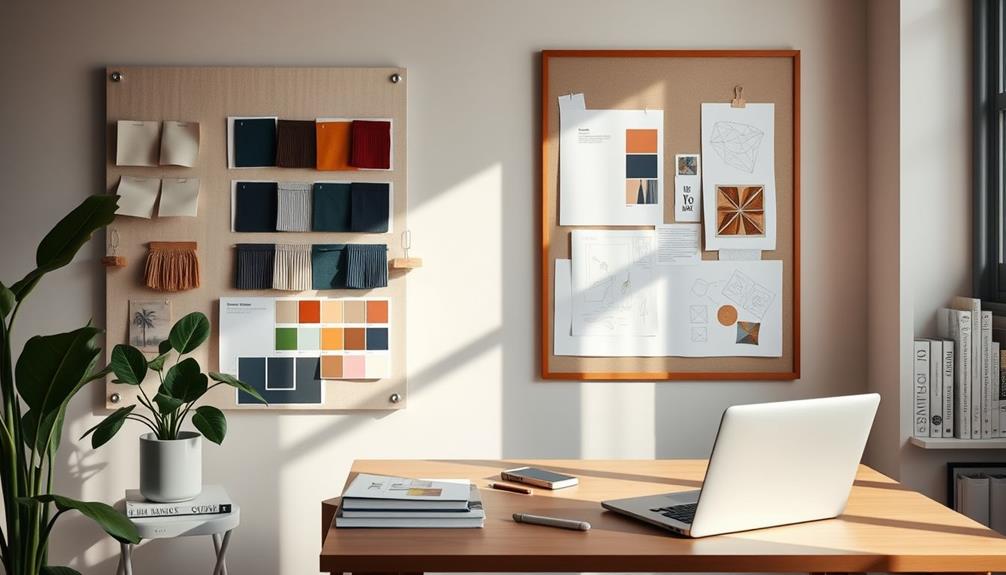To create a standout portfolio for interior design, start by choosing a format that suits your audience—consider a mix of digital and physical formats. Showcase 5-7 of your best projects, focusing on high-quality images that reflect your unique style. Highlight your design process with sketches and before-and-after photos to tell a visual story. Maintain consistent branding throughout, using a unified color scheme and typography. Don't forget to keep your portfolio updated, removing outdated work and incorporating recent projects. Follow these tips, and you'll be on your way to impressing potential clients and employers. There's so much more to explore! When curating your interior design portfolio, remember to include a variety of project types to showcase your versatility and range of skills. It’s also important to incorporate client testimonials or feedback to add credibility and demonstrate your ability to meet and exceed client expectations. These interior design portfolio tips will help you create a compelling and professional portfolio that effectively communicates your talent and expertise to potential clients and employers.
Key Takeaways
- Choose a digital, physical, or mixed format for your portfolio based on your target audience and personal branding.
- Select 5-7 standout projects that showcase your design skills and include a variety of residential and commercial designs.
- Document your design process with initial sketches, mood boards, and before-and-after images to illustrate project evolution.
- Use high-quality visuals and maintain effective white space to enhance readability and emphasize key elements of your designs.
- Regularly update your portfolio with recent projects and client testimonials to ensure relevance and showcase your evolving style.
Choose the Right Format
When you're ready to showcase your interior design work, choosing the right format is essential. You have two main options: a digital portfolio and a physical portfolio.
Digital portfolios offer greater accessibility and convenience, allowing you to present your design aesthetic across various devices. This makes it easier to share with potential clients and employers through online platforms. Additionally, incorporating elements of farmhouse front door design can enhance your presentation and show your versatility as a designer.
On the other hand, a physical portfolio creates a tangible experience that can leave a lasting impression during in-person interviews. You can even enhance it with QR codes that link to your digital content.
When deciding between formats, consider your target audience and the nature of your work. A mix of both digital and physical formats can cater to different situations effectively.
Make sure that whichever format you choose aligns with your personal branding. Consistency in visual presentation will help reinforce your design aesthetic and make your portfolio memorable.
Additionally, evaluate the benefits of using online platforms like Behance or your own personal website for a wider reach and ease of updates compared to traditional printed portfolios. Balancing these options will enhance your ability to showcase your work in the best possible light.
Showcase Your Best Work

To effectively showcase your best work, focus on selecting a handful of standout projects that truly reflect your design skills and unique style. Aim for 5-7 pieces that capture your creativity and versatility. Here's how to do it:
- Select High-Quality Images: Use high-quality images that capture the essence of your designs. Pay attention to lighting and angles to enhance visual appeal.
- Include a Variety of Project Types: Demonstrate your adaptability by including a variety of project types, such as residential and commercial designs.
- Write Concise Descriptions: Supplement each project with brief, engaging descriptions that highlight the design concept, process, and challenges overcome. Keep it concise to maintain interest.
- Regularly Update Your Portfolio: Make it a habit to regularly update your portfolio. Remove outdated work to keep your showcase relevant and reflective of your current design capabilities.
Highlight Your Design Process

To truly showcase your skills, it's crucial to document your design journey.
Include initial sketches, mood boards, and client briefs that illustrate how your ideas evolved into final designs.
This not only highlights your creative process but also demonstrates your ability to meet client needs effectively.
Documenting Your Journey
A well-documented design journey can greatly enhance your portfolio, showcasing not just the final results but the thought process behind them.
When you're documenting your journey, consider incorporating these key elements to enrich the flow of your portfolio:
- Visual Elements: Include sketches, mood boards, and color schemes to illustrate the stages of your design process. This adds depth to your body of work.
- Client Briefs: Document client briefs and project constraints succinctly. Show how you understood and addressed the client's needs throughout your design process.
- Evolution of Designs: Present initial concepts alongside final renders or professional photos. This highlights your problem-solving abilities and creativity.
- Captions and Timelines: Use concise captions to explain each phase of the design process. Incorporate before-and-after images or project timelines to narrate transformations, enhancing the storytelling aspect of your portfolio.
Visualizing Design Evolution
Visualizing the evolution of your design ideas is essential for showcasing your creative journey. In your interior designer portfolio, include sketches, mood boards, and color schemes that represent your design process. These elements effectively illustrate how your concepts evolve from initial ideas to final outcomes, making your portfolio engaging and informative.
To showcase stages of each design project, document the progression from brainstorming to drafts and revisions. This approach highlights your problem-solving skills and design thinking. Use concise captions alongside each visual to provide context without overwhelming viewers with too much text.
Don't forget to highlight client briefs; they set the stage for your design solutions and demonstrate how your work aligns with specific project goals.
Conclude with high-quality professional renders or photographs of the final design, emphasizing the transformation from concept to completion.
Use High-Quality Visuals

Using high-quality visuals is essential for making your interior design portfolio stand out. Clear, well-lit images and professional photographs showcase your skills and help potential clients appreciate the details of your work.
Importance of Visual Quality
The impact of high-quality visuals in your interior design portfolio can't be overstated; they serve as a powerful first impression that captivates potential clients and employers.
To guarantee your visuals shine, consider these key points:
- Professional Photographs: Use well-lit, high-resolution images of completed projects to enhance credibility and showcase your attention to detail.
- 3D Renderings: Incorporate 3D renderings to effectively communicate your design vision and technical skills, making your projects relatable and engaging.
- Clean Presentation: Avoid clutter in your visuals. A clean presentation allows viewers to easily absorb information and appreciate the design elements without distraction.
- Diverse Visuals: Include a mix of sketches, mood boards, and final renders to provide an all-encompassing view of your design process, showcasing your creativity and problem-solving abilities.
Techniques for High-Quality Imagery
How can you guarantee your interior design imagery stands out? Start by using a professional camera or a high-quality smartphone with an excellent lens. Optimize your lighting and angles to highlight the key features of your designs. The right visuals can make a significant impact on your ability to attract interior design clients.
Once you've captured your images, enhance them using software like Adobe Lightroom or Photoshop. Adjust colors, brightness, and correct any distortions to achieve polished, appealing visuals. Incorporate a variety of shots: wide-angle views to showcase entire spaces, close-ups for intricate details, and before-and-after comparisons to demonstrate transformation.
Aim for high-quality imagery by ensuring your images are high resolution (at least 300 DPI) for printed portfolios and optimized (72 DPI) for digital displays. This keeps your visuals crisp, regardless of how they're viewed.
Lastly, create a cohesive visual narrative throughout your portfolio. Use consistent lighting, color grading, and composition techniques across all images. This not only enhances your professionalism but also helps potential clients connect with your style and vision.
Emphasize Visual Storytelling

Capturing the essence of each project through impactful visuals creates a compelling narrative in your interior design portfolio. To emphasize visual storytelling effectively, focus on these key elements:
- Diverse Visuals: Incorporate high-quality photographs, sketches, and mood boards to illustrate the design process and showcase the evolution of your projects from concept to completion.
- Concise Captions: Use brief captions and bullet points to provide context without overwhelming viewers with lengthy descriptions. This enhances engagement and readability, allowing your designs to shine.
- Highlight Achievements: Showcase your standout achievements through striking visuals that quickly grab attention. Be selective and include only your best work to appeal to potential clients.
- Embrace White Space: Utilize white space strategically in your layout. This helps focus attention on key visuals and improves the overall flow of your portfolio, making it easier for viewers to absorb information.
Maintain Consistent Branding

Establishing consistent branding in your interior design portfolio strengthens your professional identity and creates a cohesive narrative that resonates with potential clients. To achieve this, start with a unified color scheme and typography that reflect your design aesthetic. This visual style should be recognizable and consistent throughout your portfolio, enhancing your personal brand.
Incorporate your logo and branding materials in every section of the portfolio. This not only enhances visibility but also aids brand recall among viewers. Be mindful of your font choices; limit the variety to two or three complementary fonts that maintain clarity and align with your overall design aesthetic. This helps to reinforce a polished and professional look.
It's essential to regularly update your portfolio to reflect any changes in your branding strategy. Confirm that all visuals and text align with your current design philosophy and market positioning.
This ongoing maintenance of consistent branding will keep your portfolio relevant and engaging, making a lasting impression on potential clients. By doing so, you'll elevate your professional identity and foster a stronger connection with your audience.
Utilize White Space Effectively

In your interior design portfolio, effective use of white space can transform the viewer's experience by enhancing focus on key design elements.
By incorporating ample white space, you allow your visuals to speak, making them stand out and improving readability. This intentional design choice not only elevates the professionalism of your portfolio but also adds an element of elegance.
Here are four ways to utilize white space effectively:
- Frame Your Visuals: Surround images with adequate empty space to draw attention and create a sophisticated look.
- Guide the Eye: Use white space to lead viewers through your portfolio, showcasing the flow of design concepts and final outcomes.
- Emphasize Key Elements: Strategically place empty areas around standout pieces to reinforce your aesthetic vision and make them more impactful.
- Balance Content: Ascertain that text and images are well-spaced to avoid clutter, offering a clean layout that enhances overall readability.
Avoid Common Mistakes

While effective white space can enhance your portfolio, avoiding common mistakes is equally important to guarantee your work shines. First, limit your font types to two or three complementary choices. Using too many can create visual chaos, detracting from the professionalism of your presentation.
Next, don't overcrowd your pages with excessive text; instead, prioritize impactful visuals and concise descriptions. This keeps potential clients engaged and helps them understand your work.
Another tip is to steer clear of outdated or less impressive pieces. A cluttered portfolio can dilute the perception of your skills, so focus on showcasing your best work. Avoid using small text sizes or overly decorative fonts, which can hinder readability. Aim for clear typography that enhances your overall presentation.
Lastly, always present your projects with context. Include client briefs, design processes, and visual elements to illustrate your journey. This not only demonstrates your technical drawings but also emphasizes your approach to successful interior design.
Continuously Update Your Portfolio

Updating your portfolio regularly is essential for showcasing your latest design style and skills. An up-to-date portfolio not only reflects your current abilities but also enhances your marketability to potential clients.
Here are some key strategies to keep your portfolio fresh:
- Incorporate Recent Projects: Add your latest work to highlight your evolving design style and capabilities.
- Include Client Feedback: Use testimonials to demonstrate your adaptability and responsiveness, traits that clients highly value.
- Remove Outdated Work: Eliminate older or less impressive projects to maintain a focused and impactful presentation that emphasizes quality over quantity.
- Stay Informed on Industry Trends: Regularly research and incorporate current trends to guarantee your portfolio remains relevant and appealing.
Set a schedule for portfolio reviews and updates, such as quarterly or biannually. This consistency will help you reflect your evolving skills and design philosophy.
By actively updating your portfolio, you'll not only attract new clients but also position yourself as a knowledgeable professional in the interior design industry.
Conclusion
Creating a strong interior design portfolio is like crafting a beautiful room; every detail counts. By choosing the right format and showcasing your best work, you'll not only highlight your unique style but also tell a compelling story. Remember to keep updating your portfolio and avoid common pitfalls. With stunning visuals and a consistent brand, you'll invite clients into your creative world, making it impossible for them to resist wanting to collaborate with you.









